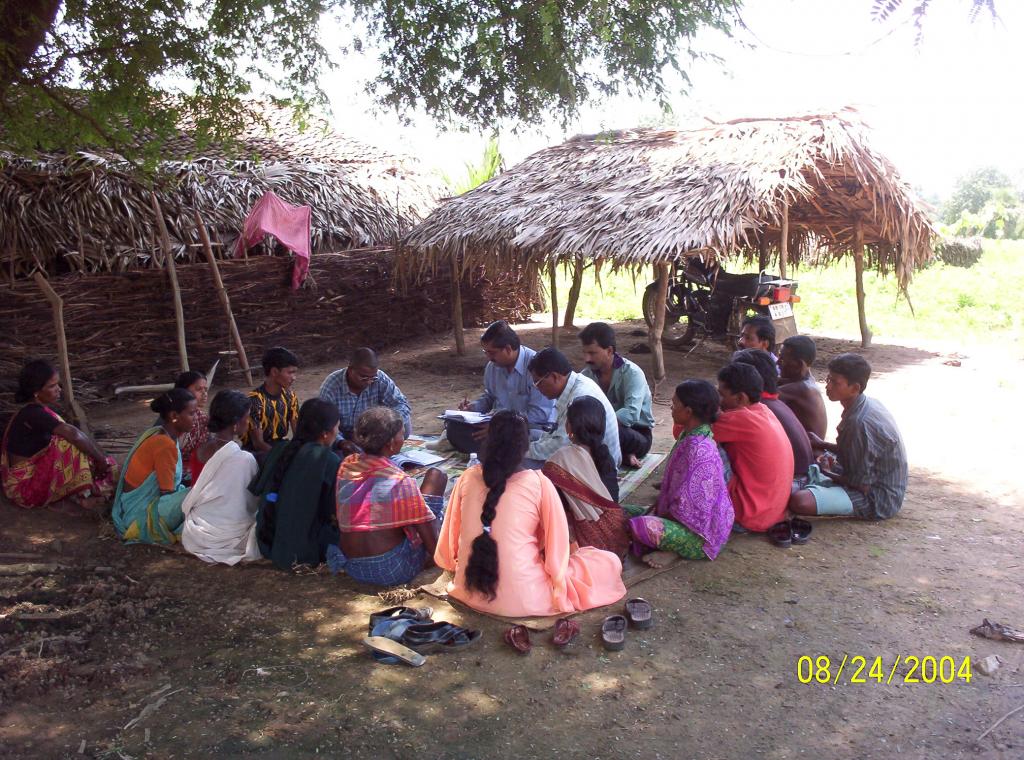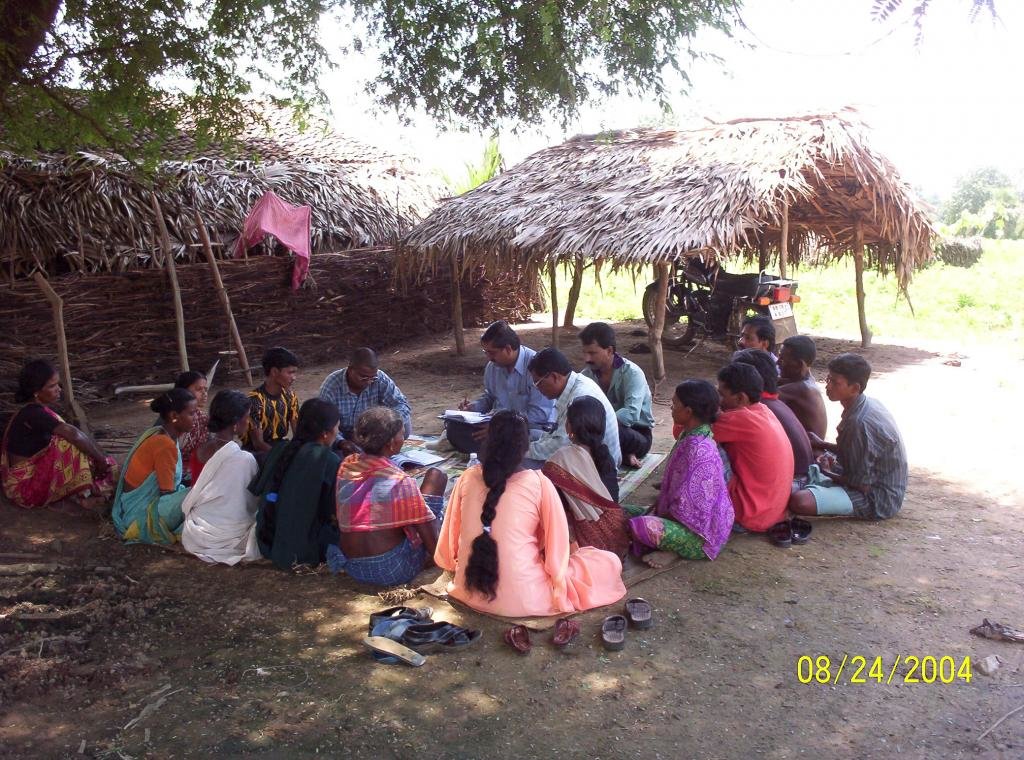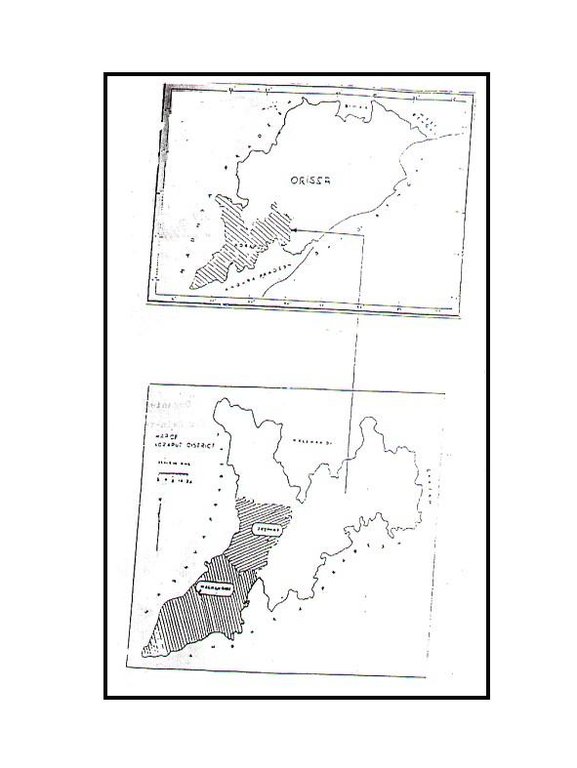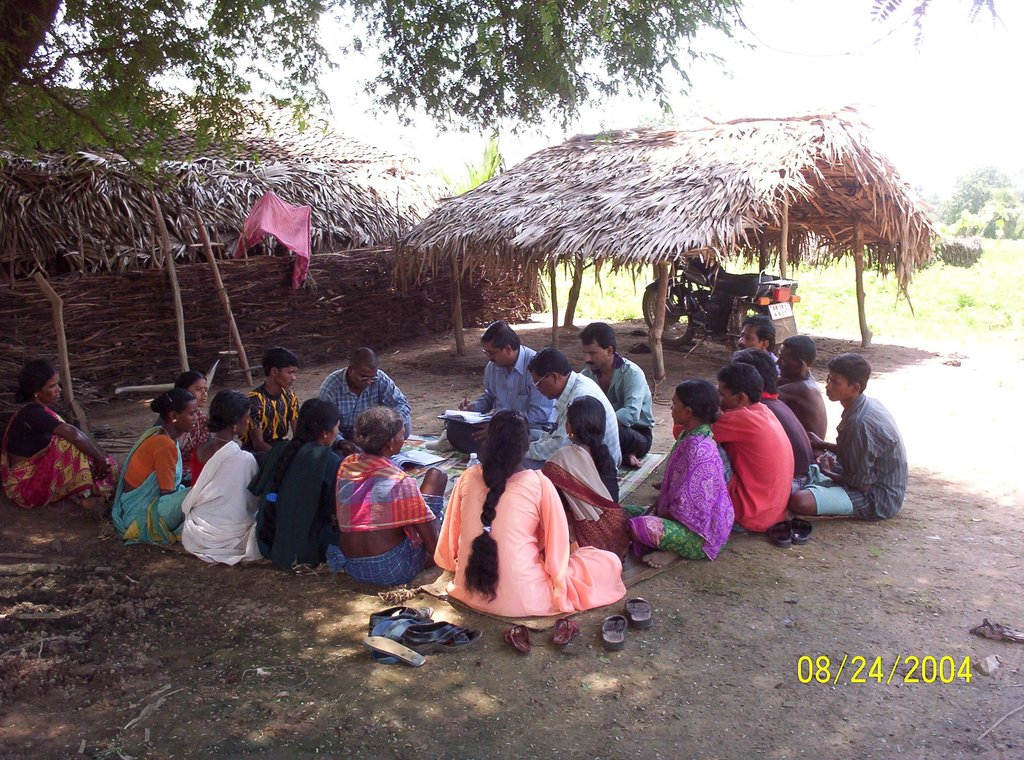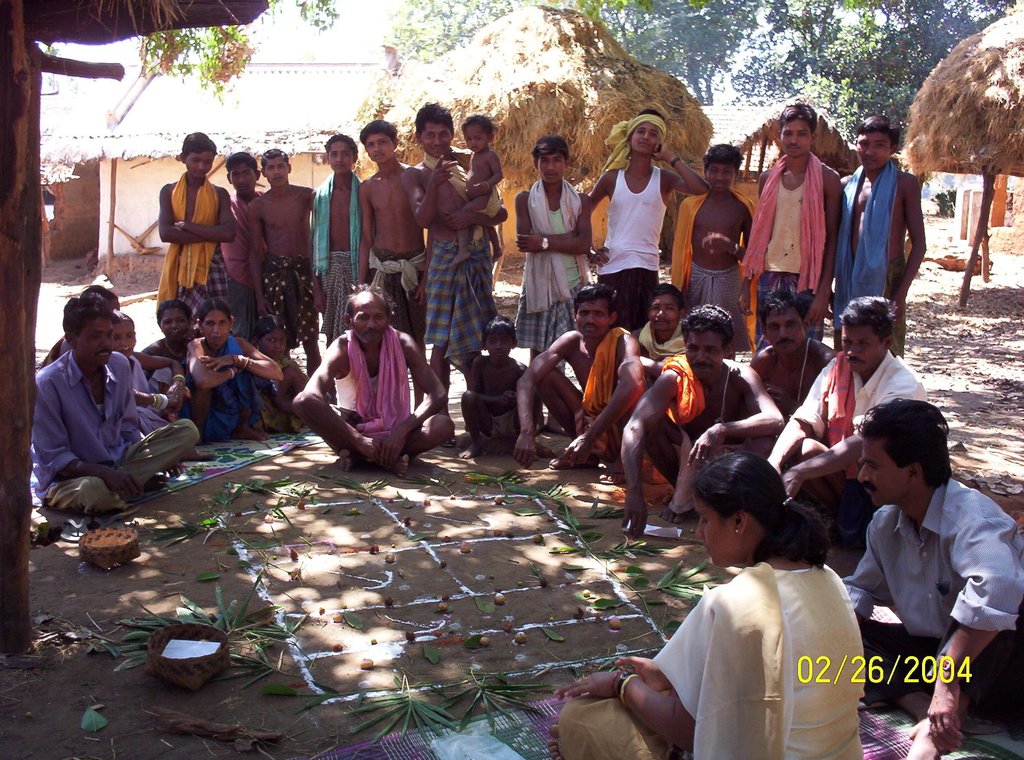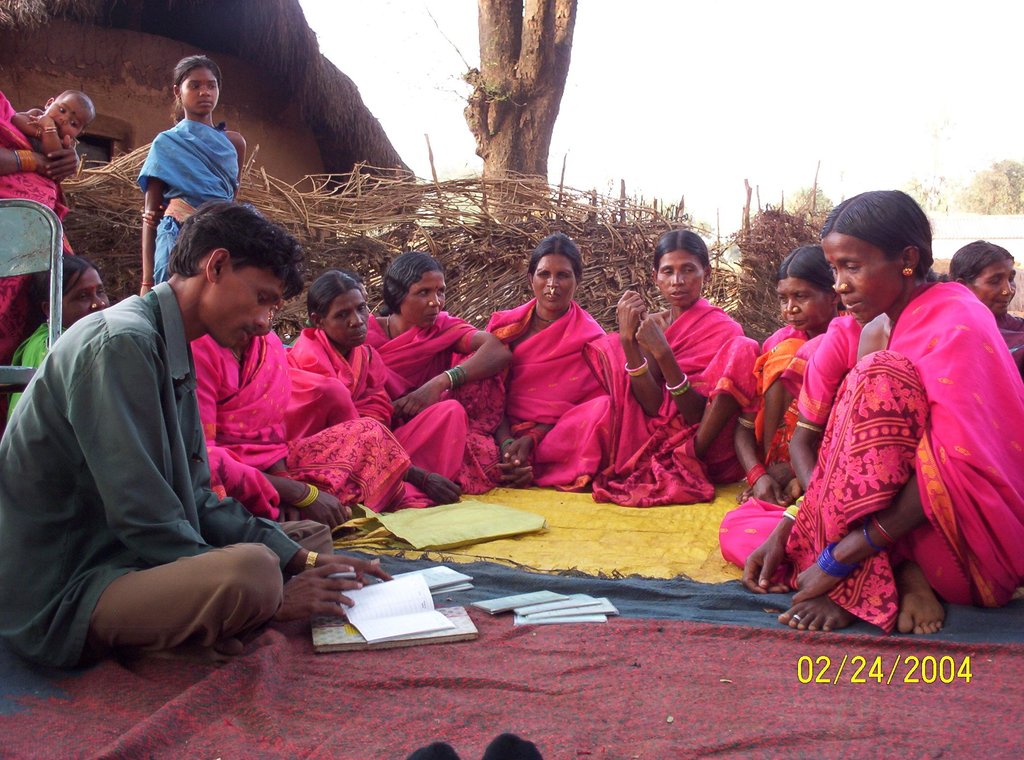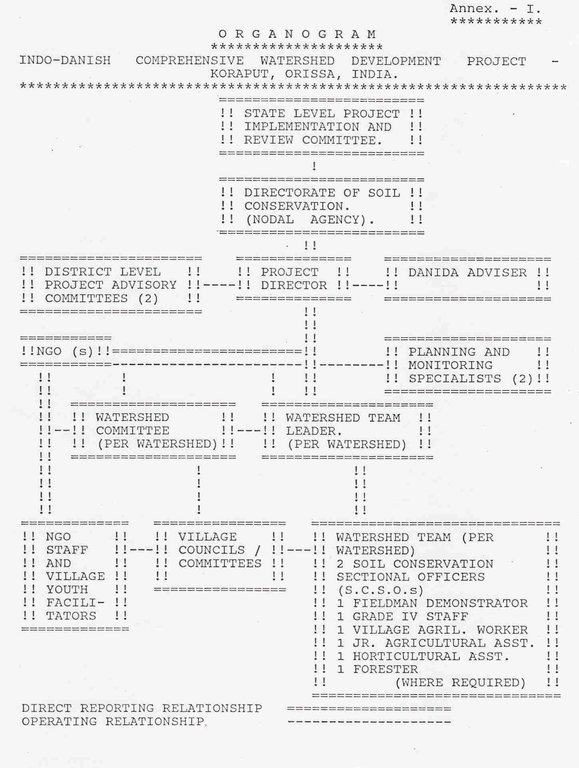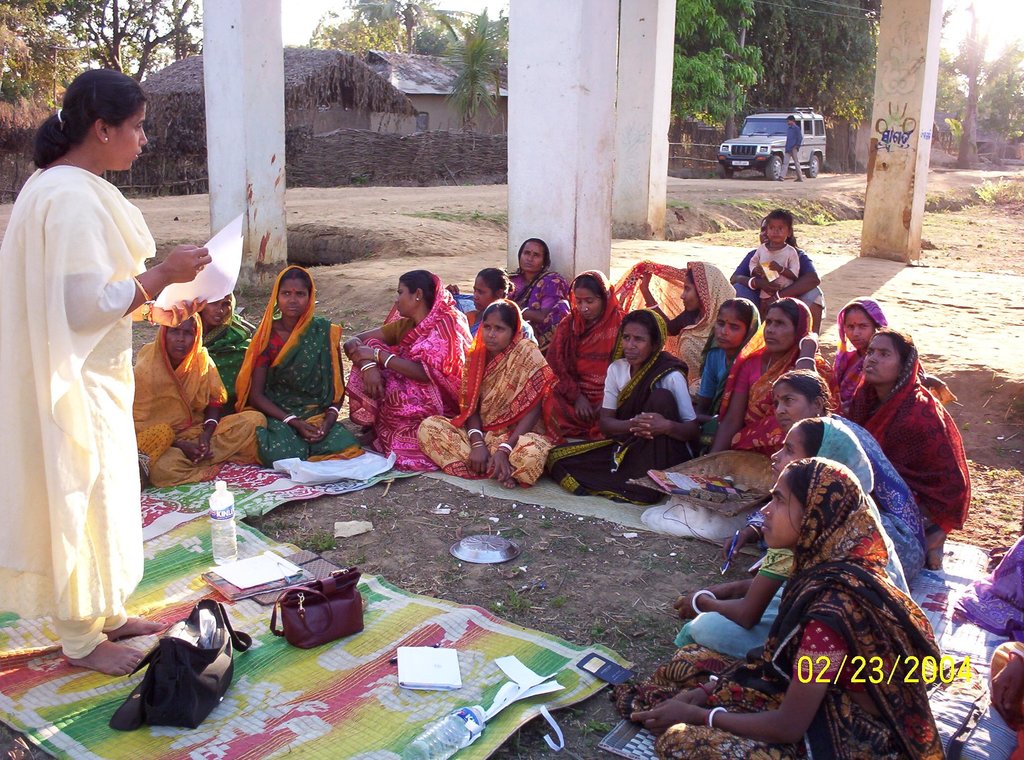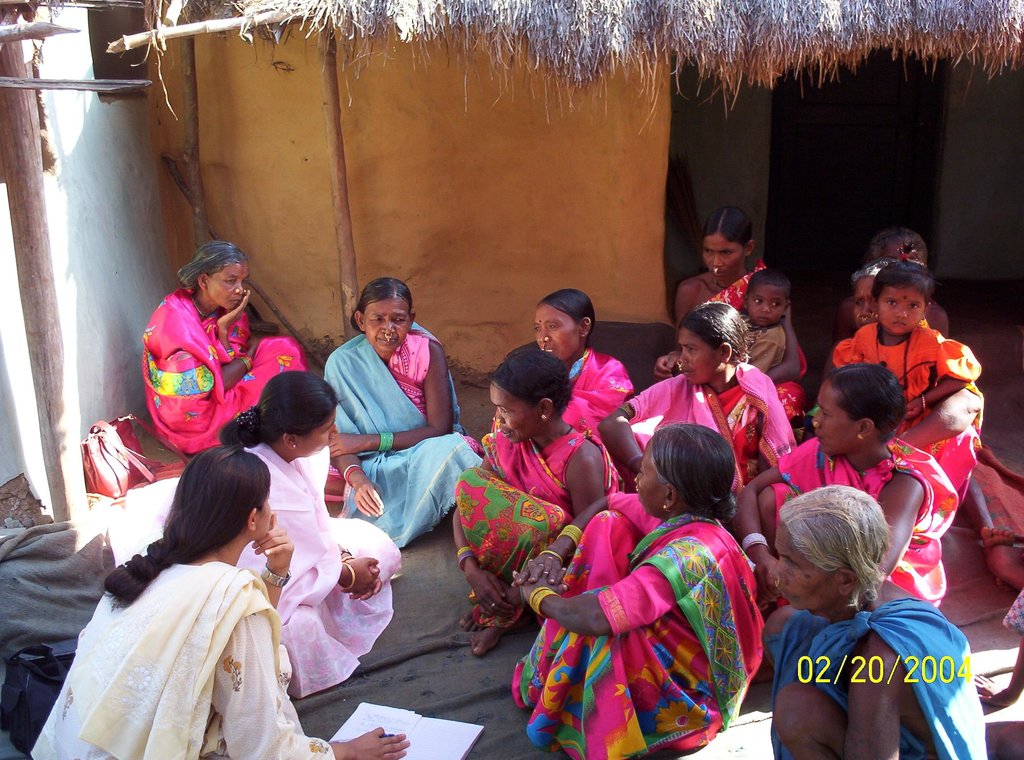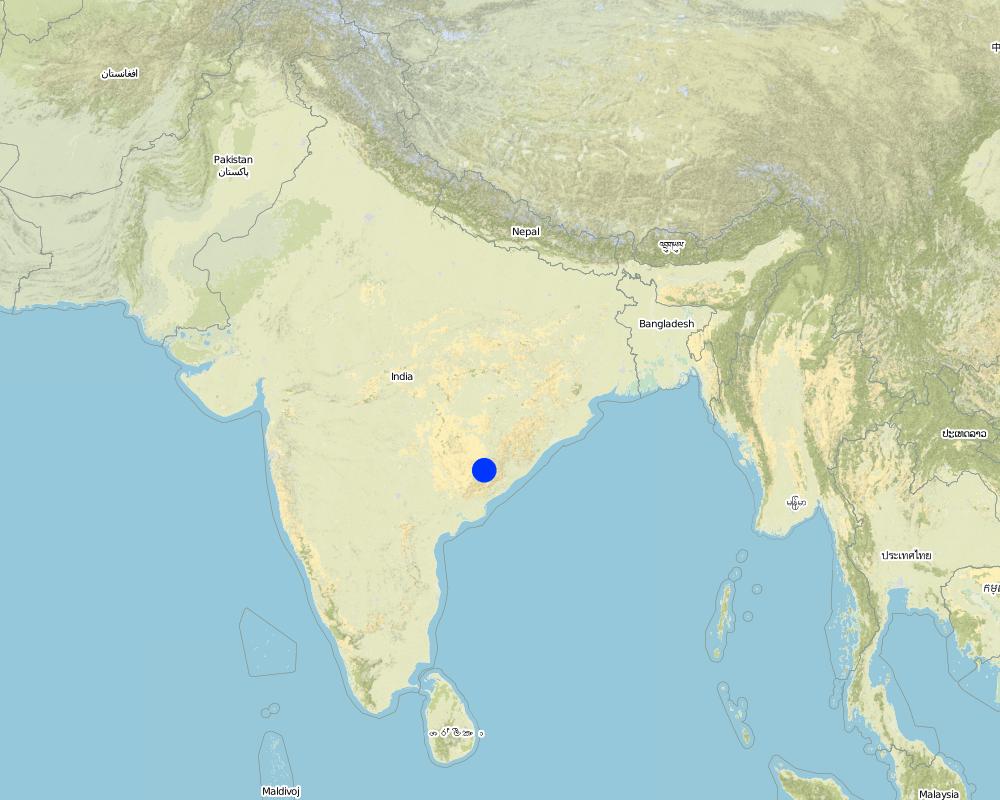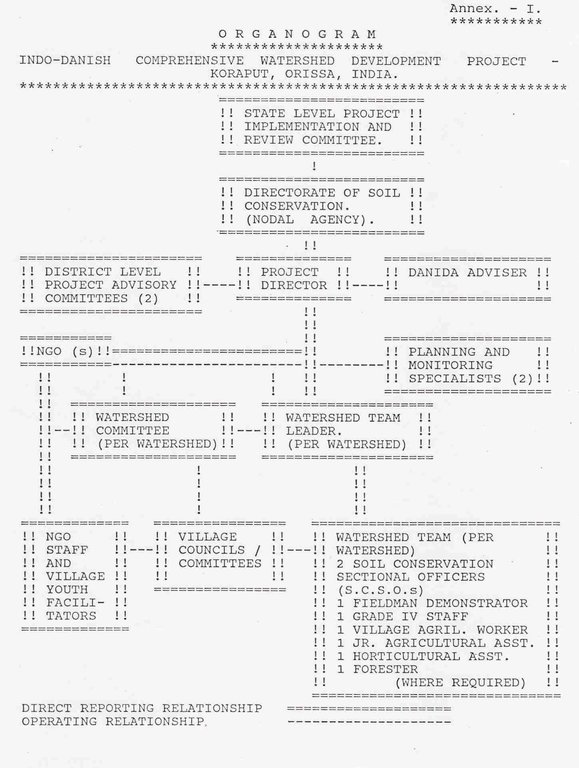PARTICIPATORY APPROACH IN IDCWDP, DANIDA [ອິນເດຍ]
- ການສ້າງ:
- ປັບປູງ:
- ຜູ້ສັງລວມຂໍ້ມູນ: Srikanta Kumar Parida
- ບັນນາທິການ: –
- ຜູ້ທົບທວນຄືນ: Fabian Ottiger
approaches_2372 - ອິນເດຍ
ເບິ່ງພາກສ່ວນ
ຂະຫຍາຍທັງໝົດ ຍຸບທັງໝົດ1. ຂໍ້ມູນທົ່ວໄປ
1.2 ລາຍລະອຽດ ການຕິດຕໍ່ ຂອງບຸກຄົນທີ່ຊັບພະຍາກອນ ແລະ ສະຖາບັນ ການມີສ່ວນຮ່ວມ ໃນການປະເມີນຜົນ ແລະ ເອກະສານ ຂອງວິທີທາງ
ຜູ້ຊ່ຽວຊານ ດ້ານການຄຸ້ມຄອງ ທີ່ດິນແບບຍືນຍົງ:
BIJAYALAXMI Mishra
ອິນເດຍ
ຊື່ຂອງ ສະຖາບັນການຈັດຕັ້ງ ທີ່ອໍານວຍຄວາມສະດວກ ໃນການສ້າງເອກກະສານ ຫຼື ປະເມີນແນວທາງ (ຖ້າກ່ຽວຂ້ອງ)
Orissa Government - ອິນເດຍ1.3 ເງື່ອນໄຂ ຂອງການນໍາໃຊ້ເອກກະສານຂໍ້ມູນ ຂອງ WOCAT
ຜູ້ສັງລວມ ແລະ ບັນດາຜູ້ຕອບແບບສອບຖາມ ຍອມຮັບໃນເງື່ອນໄຂ ການນໍາໃຊ້ຂໍ້ມູນເອກະສານ ທີ່ສ້າງຂື້ນ ໂດຍຜ່ານ ອົງການ WOCAT:
ແມ່ນ
1.4 ເອກະສານອ້າງອີງ (ຫຼາຍ) ກັບແບບສອບຖາມ (ຫຼາຍ) ເຕັກໂນໂລຢີ ຂອງດ້ານການຄຸ້ມຄອງ ດິນແບບຍືນຍົງ
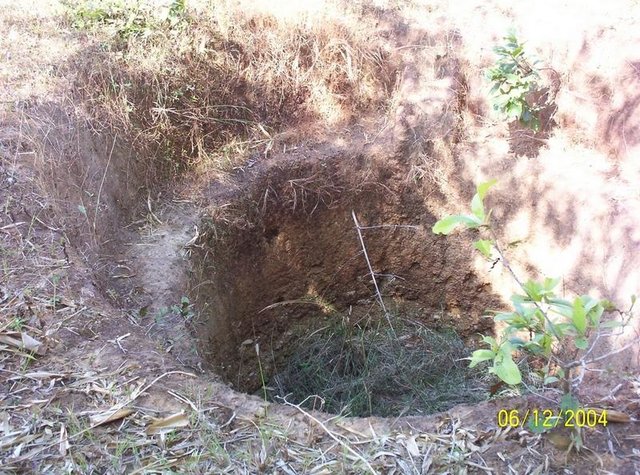
Integrated Farming System [ອິນເດຍ]
Growing of crops for food, fodder trees and fibre forest in a compact patch.
- ຜູ້ສັງລວມຂໍ້ມູນ: Srikanta Kumar Parida
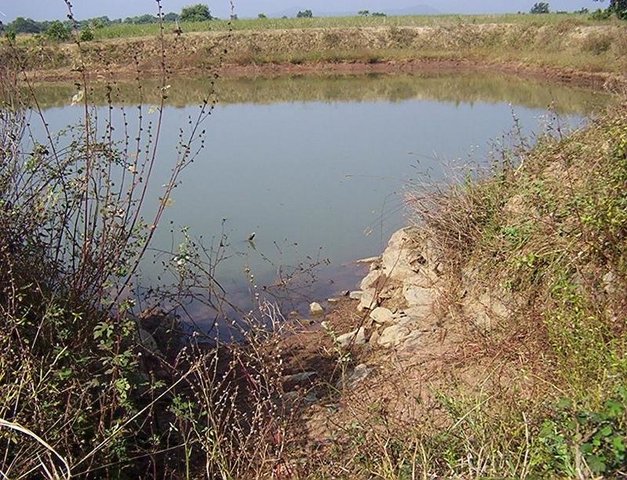
Dugout Sunken Pond with Catchment Treatment [ອິນເດຍ]
Dugout sunken pond with catchment treatment.
- ຜູ້ສັງລວມຂໍ້ມູນ: Unknown User
2. ພັນລະນາ ແນວທາງການຄຸ້ມຄອງນໍາໃຊ້ດິນແບບຍືນຍົງ
2.1 ການອະທິບາຍ ໂດຍຫຍໍ້ ຂອງວິທີທາງ
Participatory approach for holistic and intigrated development of the defined area on watershed basis involving all level of stake holders.
2.2 ການອະທິບາຍ ລາຍລະອຽດ ຂອງວິທີທາງ
ການອະທິບາຍ ລາຍລະອຽດ ຂອງວິທີທາງ:
Aims / objectives: Long term - Establish suitable and locally acceptable land use system which are sustainable and ecologically sound.The land use system should enable the poor rural community to improve their living condition and tsupply of food, fuel and fodder and other essentials, without exposing the natural resources to harmful stress. Intermediate Objective- Preserve the resource base by introducing improvemnets which are feasible, effective and attractive to the target groups in the area by combining elements of soil conservation, crop production, horticulture, animal husbandary and tree planting in such a way that sustaibale use is made of every niche of land within the watershed.
Methods: (1) Mobilization of community by NGO/ GO people through meetings. (2) Demonstration at the field level. (3) Organizing farmers field day. (4) Exposure visit to the watershed area. (5) Training. (6) Land development activities,
Stages of implementation: (1) Socio economic survey. (2) Participatory Rural Apprisal (PRA). (3) Preparation of participatory annual action plan with the community and village and watershed committee. (4) Consolidation of annual action plan by project management unit and circulation for comments to WDCU, DSC(O). (5) Approval of annual action plan by the state level project empowered committee and sanction of funds. (6) Implementation through community and mobilisation for labour contribution by the community (if such component are there). (7) Training at the field level. (8) Organizing monitoring by the community/ Specialist.
Role of stakeholders: NGO (Field Organizers)- Organizing village meeting and mobilization of community towards different activities and labour contribution organising PRA, meeting, group discussion, survey, formation of committee, preparation of AAP. Villagers:- Attendance of meeting, selection of beneficiaries from the target group and sites for different activities. Monitoring and implementation (Physical) of the activity. Youth facilitator:- The village youth facilitators played a key role through out the process of planning, implementation and monitoring and to solve the problems in case arises at any stage of the work. The village yourth facilitator acted as the link person between the community and the project. SWC (From Project management Unit) - Supervision, training to the SWC specialist, communicate new technology to the community. Beneficiaries:- Implementation, contribution of labour selection of his own land for SWC technology, monitoring, receive training, training before/during/afteer care.
Other important information: Government and NGO collaborately played a vital role to bring all level of stak holders to a common forum of participation.
2.3 ຮູບພາບຂອງແນວທາງ
2.5 ປະເທດ / ເຂດ / ສະຖານທີ່ບ່ອນທີ່ແນວທາງໄດ້ຖືກນໍາໃຊ້
ປະເທດ:
ອິນເດຍ
ພາກພື້ນ / ລັດ / ແຂວງ:
Orissa
Map
×2.6 ວັນທີເລີ່ມຕົ້ນ ແລະ ສິ້ນສຸດ ການຈັດຕັ້ງປະຕີບັດ ວິທີທາງ
ປີທີ່ສີ້ນສູດ (ຖ້າຢຸດບໍ່ໄດ້ນໍາໃຊ້ ວິທີທາງ):
2003
2.7 ປະເພດຂອງແນວທາງ
- ພາຍໃຕ້ໂຄງການ / ແຜນງານ
2.8 ເປົ້າໝາຍ / ຈຸດປະສົງຫຼັກ ຂອງການຈັດຕັ້ງປະຕິບັດ ວິທີທາງ
The Approach focused mainly on SLM with other activities (Live stock development, SHG formation, management group, development of local committee, income generating, identification of 10 poorest and support for upliftment, training, women empowerment)
Long term - Establish suitable and locally acceptable land use system which are sustainable and ecologically sound. The land use system should enable the poor rural community to improve their living condition and tsupply of food, fuel and fodder and other essentials, without exposing the natural resources to harmful stress. Intermediate Objective- Preserve the resource base by introducing improvemnets which are feasible, effective and attractive to the target groups in the area by combining elements of soil conservation, crop production, horticulture, animal husbandary and tree planting in such a way that sustaibale use is made of every niche of land within the watershed. -Ease the pressure on non arable lands by increasing the productivity of land which is suitable for more intensive use which is suitable for more intesive use without risk of loss in soil fertility. -Provide marginal farmers and landless people with assests which yield essentials or generate income possibilities. Immediate: Relevant authorities will identify, plan for implement and monitor proper conservation measures and land use system acceptable and in cooperation with the people in the project area of Koraput and Malkangiri districts. Thereby increase production of agricultural and other rural products and improve gainful, empowerment opportunity for men and women among landless , small and marginal farmers.
The SLM Approach addressed the following problems: (1) Both the project districts like Koraput & Malkangiri are among the most poor, backward with 90% of the house hold are below the official poverty line. Literacy rate is just above 10%. (2) The dry land farming is predeminant activity. (3) The soil in the districts suffer from severe land degradation and erosion problems needing protectin and preservation measures.
2.9 ເງື່ອນໄຂອໍານວຍ ຫຼື ຂັດຂວາງການປະຕິບັດຂອງເຕັກໂນໂລຢີ / ເຕັກໂນໂລຢີການນໍາໃຊ້ຕາມແນວທາງ
ສັງຄົມ / ວັດທະນະທໍາ / ມາດຕະຖານ ແລະ ຄຸນຄ່າທາງສາສະໜາ
- ເຊື່ອງຊ້ອນ
(1) No faith on Govt. people. (2) Practice on not participapting in any Govt. programme. (3) No women participation in any common gathering. (4) Dominance of influencial persons in the villages. (5) No participation of poors in any developmental work.
Treatment through the SLM Approach: (1) Repeated meeting by Govt. and NGO staff (2) Greter importance to the poorer section through out the process. (3) Identification of 10 poorest family in each village (4) Engagement of Lady organizer to oroganize the women of the respective area. (5) Fo
ມີຄວາມສາມາດ / ເຂັ້າເຖິງຊັບພະຍາກອນດ້ານການເງິນ ແລະ ການບໍລິການ
- ເຊື່ອງຊ້ອນ
Irregular flow of fund by the sanction authority which hampered the season based activities.(2)Achieve the targetted amount of contribution for different activities from the community.
Treatment through the SLM Approach: The irregular funds flow continued till end of the programme.But regarding contribution component it was reduced from the 50% to20% in amount at the policy level which could be achieved by community mobilisation through NGO who were associated as the proj
ກ່ຽວກັບກົດໝາຍ (ສິດນໍາໃຊ້ດິນ, ສິດນໍາໃຊ້ນໍ້າ)
- ເຊື່ອງຊ້ອນ
The existing land ownership, land use rights / water rights hindered a little the approach implementation Due to ignorance of the people, initially it was difficult to take up any activity in farmers land since the apprehensive of loss of llllland by the Govt. Staff was existing in the mind of land users.
3. ການມີສ່ວນຮ່ວມ ແລະ ບົດບາດຂອງພາກສ່ວນທີ່ກ່ຽວຂ້ອງທີ່ໄດ້ມີສ່ວນຮ່ວມ
3.1 ຜູ້ມີສ່ວນຮ່ວມ ໃນວິທີທາງ ແລະ ພາລະບົດບາດ ຂອງເຂົາເຈົ້າ
- ຜູ້ນໍາໃຊ້ດິນໃນທ້ອງຖິ່ນ / ຊຸມຊົນທ້ອງຖິ່ນ
Land less and Small/marginal farmers
Work equally divided between men and women (Both men and women work on common land activities, the land users worked combinely and in most of the private activities work done individualy. Though the male and female do all type of work, but due to their usual practice the women participation was very less in the initial period of the project. But due to the presence of the NGO in the project, they could be brought in the main stream of the project and by which many successful women self help group than the male group could be organized. The project has earmarked poor as main target froup. Through NGO they have been encouraged and mobilized to partcipate in project activities. As per the project guide line no land less and the small/ marginal farmers have their representation in the village committee/watershed committee wheremajor decission taken place. During implementation they priority for engegement of labour and income.
- ອົງການຈັດຕັ້ງ ທີ່ບໍ່ຂື້ນກັບລັດຖະບານ
NGO as project partner
- ພະນັກງານຂັ້ນສູນກາງ (ຜູ້ວາງແຜນ, ຜູ້ສ້າງນະໂຍບາຍ)
Ministry of Agriculture, India.
(1) Watershed development coordination unit (2) State Agriculture Department (3) Director of Soil Conservation
3.2 ການມີສ່ວນຮ່ວມຂອງຜູ້ນໍາໃຊ້ທີ່ດິນໃນທ້ອງຖິ່ນ / ຊຸມຊົນທ້ອງຖິ່ນໃນໄລຍະທີ່ແຕກຕ່າງກັນຂອງແນວທາງ
| ການລວບລວມ ເອົາຜູ້ນໍາໃຊ້ດິນ ໃນທ້ອງຖິ່ນ / ຊຸມຊົນທ້ອງຖິ່ນ | ໃຫ້ລະບຸ ຜູ້ໃດທີ່ມີສ່ວນຮ່ວມ ໃນແຕ່ລະກິດຈະກໍາ? | |
|---|---|---|
| ການເລີ່ມຕົ້ນ / ແຮງຈູງໃຈ | ການຊ່ວຍເຫຼືອຈາກພາຍນອກ | public meetings; General village level meeting organized village committee members selected. Youth facilitator selected. Due to presence of NGO all villagers were mobilized to join in the mainstream of the project. |
| ການວາງແຜນ | ການຮ່ວມມື | All community were associated in planning meeting and PRA . Addl land survey made in association with land users. Need assessment made for each house hold in association with the villagers. Approval of action plan in watershed and village committee. |
| ການປະຕິບັດ | ການຊ່ວຍເຫຼືອຈາກພາຍນອກ | |
| ຕິດຕາມກວດກາ / ການປະເມີນຜົນ | ການຮ່ວມມື | At different level of meeting the land users views collected. The watershed committee (consisting of members from all villages) was the main body for monitoring and evaluation of the activities. |
| Research | ການຮ່ວມມື | on-station; Only for limited activities some soil testing made in the soil research station of the district. |
3.3 ແຜນວາດ (ຖ້າມີ)
3.4 ການຕັດສິນໃຈກ່ຽວກັບການຄັດເລືອກເຕັກໂນໂລຢີຂອງການຄຸ້ມຄອງທີ່ດິນແບບຍືນຍົງ / ເຕັກໂນໂລຢີ
ລະບຸ ຄົນທີ່ຕັດສິນໃຈ ກ່ຽວກັບການຄັດເລືອກຂອງ ເຕັກໂນໂລຢີ / ເຕັກໂນໂລຢີ ຈະໄດ້ຮັບການປະຕິບັດ:
- ຜູ້ນໍາໃຊ້ທີ່ດິນຫຼັກ, ການສະໜັບສະໜູນ ໂດຍຜູ້ຊ່ຽວຊານ ການນໍາໃຊ້ທີ່ດິນແບບຍືນຍົງ
ອະທິບາຍ:
Many technologies has been takn up from the guide line of NWDPRA. But some are also innovative one emerged from the project level. However whenever any technology decided to be implemented, the land users view aloways respected for sustainable of the activity and transferred appropriate technology.
Decisions on the method of implementing the SLM Technology were made by mainly by land users supported by SLM specialists. Relating to the method of implementation fo the activity, the suggestion of the land users played a vital role.
4. ການສະໜັບສະໜູນທາງດ້ານວິຊາການ, ການສ້າງຄວາມສາມາດ, ແລະ ການຈັດການຄວາມຮູ້.
4.1 ການສ້າງຄວາມສາມາດ / ການຝຶກອົບຮົມ
ຜູ້ນໍາໃຊ້ທີ່ດິນ ຫຼື ພາກສ່ວນກ່ຽວຂ້ອງອື່ນໆ ໄດ້ຮັບການຝຶກອົບຮົມບໍ່?
ແມ່ນ
ໃຫ້ລະບຸ ຜູ້ໃດທີ່ໄດ້ຮັບການຝຶກອົບຮົມ:
- ຜູ້ນໍາໃຊ້ດິນ
- SWC specialists, extensionists/trainers, Local Invitor
ຮູບແບບຂອງການຝຶກອົບຮົມ:
- ການເຮັດຕົວຈິງ
- ຕົວຕໍ່ຕົວ
- ເນື້ອທີ່ສວນທົດລອງ
- ກອງປະຊຸມ
- ຫຼັກສູດ
ຮູບແບບຂອງການຝຶກອົບຮົມ:
- Courses and class room training
ໃນຫົວຂໍ້:
Method of implementation, merits, demerits of the technology, maintenance, socio-economic dimension, exposure visit, management committee formation for sustainability of the technolotgy.
4.2 ການບໍລິການໃຫ້ຄໍາປຶກສາ
ເຮັດຜູ້ໃຊ້ທີ່ດິນມີການເຂົ້າເຖິງການບໍລິການໃຫ້ຄໍາປຶກສາ?
ແມ່ນ
ລະບຸວ່າການສະໜອງ ການບໍລິການ ໃຫ້ຄໍາປຶກສາ:
- ສູນຄົ້ນຄວ້າ
ອະທິບາຍ / ຄວາມຄິດເຫັນ:
Name of method used for advisory service: Training and exposure visit, demonstration, meeting.; Key elements: Meeting and group discussion., Individual beneficiary interaction., Filed visit and watershed level exihibition.; 1) Advisory service was carried out through: projects own extension structure and agents; Extension staff: mainly government employees 3) Target groups for extension: land users; Activities: Demonstration, exposure visit, training, meeting, group discussion
Advisory service is inadequate to ensure the continuation of land conservation activities; In knowledge it is adequate, but the approach is plicy based. So the continuation can not be guaranted fully.
4.3 ສະຖາບັນການສ້າງຄວາມເຂັ້ມແຂງ (ການພັດທະນາອົງການຈັດຕັ້ງ)
ສະຖາບັນ ໄດ້ຮັບການສ້າງຕັ້ງຂື້ນ ຫຼື ໄດ້ຮັບການສ້າງຄວາມເຂັ້ມແຂງ ໂດຍການຈັດຕັ້ງປະຕິບັດ ວິທີທາງບໍ່?
- ມີ, ພໍສົມຄວນ
ລະບຸ ທາງສະຖາບັນ ໄດ້ສ້າງຄວາມເຂັ້ມແຂງ ໃນລະດັບໃດ (ຫຼາຍ):
- ທ້ອງຖິ່ນ
ລະບຸ ປະເພດ ຂອງສະໜັບສະໜູນ:
- ການສ້າງຄວາມອາດສາມາດ / ການຝຶກອົບຮົມ
4.4 ຕິດຕາມກວດກາ ແລະ ປະເມີນຜົນ
ການຈັດຕັ້ງປະຕິບັດ ວິທີທາງ ໄດ້ມີການປະເມີນຜົນ ແລະ ຕິດຕາມບໍ?
ແມ່ນ
ຄວາມຄິດເຫັນ:
bio-physical aspects were regular monitored through observationse
technical aspects were regular monitored through measurements
socio-cultural aspects were regular monitored through observations
economic / production aspects were ad hoc monitored through observations
area treated aspects were regular monitored through measurements
no. of land users involved aspects were regular monitored through measurements
management of Approach aspects were regular monitored through measurements
There were several changes in the Approach as a result of monitoring and evaluation: (1) Many new activities introduced. (2) More funds diverted to the poverty oriented activities (3) Like income generating activities changes in last norm of NGO operational expenditure to give more priority on community participation. (4) 10 poorest identified were appreciated and suggested for concetration of their socio economic upliftment.
4.5 ການຄົ້ນຄວ້າ
ນີ້້ແມ່ນສ່ວນໜຶ່ງ ການຄົ້ນຄວ້າ ຂອງວິທີທາງບໍ່?
ແມ່ນ
5. ການສະໜັບສະໜູນທາງດ້ານການເງິນ ແລະ ອຸປະກອນຈາກພາຍນອກ
5.1 ງົບປະມານປະຈໍາປີ ສໍາລັບວິທີທາງ ຂອງການຄຸ້ມຄອງ ທີ່ດິນແບບຍືນຍົງ
ຖ້າຫາກບໍ່ຮູ້ຈັດງົບປະມານທີ່ແນ່ນອນ ແມ່ນໃຫ້ປະມານເອົາ:
- < 2,000
ຄໍາເຫັນ (ຕົວຢ່າງ: ແຫຼ່ງຂໍ້ມູນຫຼັກ ຂອງການສະໜອງທຶນ / ຜູ້ໃຫ້ທຶນທີ່ສໍາຄັນ):
Approach costs were met by the following donors: government (national - Salary and other expences of staff): 18.0%; international (DANIDA 13.25): 75.0%; local community / land user(s) (-): 7.0%
5.2 ການສະໜັບສະໜູນ ທາງດ້ານການເງິນ / ອຸປະກອນ ສະໜອງໃຫ້ແກ່ຜູ້ນໍາທີ່ດິນ
ຜູ້ນໍາໃຊ້ດິນ ໄດ້ຮັບການສະໜັບສະໜູນ ທາງດ້ານ ການເງິນ / ອຸປະກອນ ໃນການຈັດຕັ້ງປະຕິບັດ ເຕັກໂນໂລຢີບໍ?
ແມ່ນ
5.3 ເງິນສົມທົບສໍາລັບການນໍາໃຊ້ສະເພາະປັດໃຈຂາເຂົ້າໃນການຜະລີດກະສິກໍາ (ລວມທັງແຮງງານ)
- ອຸປະກອນ
| ໃຫ້ລະບຸໄດ້ຮັບການສະໜັບສະໜູນປັດໃຈຂາເຂົ້າຫຍັງແດ່ | ທີ່ຂອບເຂດ | ລະບຸ ການອຸດໜູນ |
|---|---|---|
| ເຄື່ອງກົນຈັກ | ງົບປະມານເຕັມສ່ວນ | |
| ເຄື່ອງມື | ງົບປະມານເຕັມສ່ວນ | |
- ກະສິກໍາ
| ໃຫ້ລະບຸໄດ້ຮັບການສະໜັບສະໜູນປັດໃຈຂາເຂົ້າຫຍັງແດ່ | ທີ່ຂອບເຂດ | ລະບຸ ການອຸດໜູນ |
|---|---|---|
| ແນວພັນ, ແກ່ນພັນ | ງົບປະມານເຕັມສ່ວນ | |
| ຝຸ່ນ, ປຸ໋ຍ | ງົບປະມານເຕັມສ່ວນ | |
| Seedlings and biocides | ||
- ພື້ນຖານໂຄງລ່າງ
| ໃຫ້ລະບຸໄດ້ຮັບການສະໜັບສະໜູນປັດໃຈຂາເຂົ້າຫຍັງແດ່ | ທີ່ຂອບເຂດ | ລະບຸ ການອຸດໜູນ |
|---|---|---|
| Community infrastructure | ງົບປະມານເຕັມສ່ວນ | |
ຖ້າແຮງງານ ຂອງຜູ້ນໍາໃຊ້ດິນ ໄດ້ຮັບການສະໜັບສະໜູນ ປັດໃຈຂາເຂົ້າ, ແມ່ນບໍ່:
- ຈ່າຍເປັນເງິນສົດ
ຄວາມຄິດເຫັນ:
Govt. wages for their labour work.
5.4 ສິນເຊື່ອ
ໄດ້ປ່ອຍສິນເຊື່ອ ສະໜອງໃຫ້ພາຍໃຕ້ ວິທີການສໍາລັບກິດຈະກໍາ ການຄຸ້ມຄອງ ທີ່ດິນແບບຍືນນຍົງບໍ່?
ບໍ່ແມ່ນ
6. ວິເຄາະຜົນກະທົບ ແລະ ສັງລວມບັນຫາ
6.1 ຜົນກະທົບຂອງແນວທາງ
ການຈັດຕັ້ງປະຕິບັດ ວິທີທາງ ສາມາດຊ່ວຍຜູ້ນໍາໃຊ້ທີ່ດິນ ໃນການຈັດຕັ້ງປະຕິບັດ ແລະ ບໍາລຸງຮັກສາ ເຕັກໂນໂລຢີ ການຄຸ້ມຄອງ ທີ່ດິນແບບຍືນຍົງໄດ້ບໍ?
- ບໍ່
- ມີ, ໜ້ອຍໜຶ່ງ
- ມີ, ພໍສົມຄວນ
- ມີ, ຫຼາຍ
The importance of low cost oriented appopriate technology of the project attracted to a greater part of the community. The land users have also trainined on implementation of technology like veg.bunding, water hole, V-ditch, excavation of ponds, structure, plantation, cave of natural forest etc.
ການຈັດຕັ້ງປະຕິບັດ ວິທີທາງ ສາມາດປັບປຸງ ປະເດັນການຖືຄອງທີ່ດິນ / ສິດທິໃນການນໍາໃຊ້ທີ່ດິນ ທີ່ເຊື່ອງຊ້ອນໃນການຈັດຕັ້ງປະຕິບັດ ເຕັກໂນໂລຢີ ການຄຸ້ມຄອງ ທີ່ດິນແບບຍືນຍົງໄດ້ບໍ?
- ບໍ່
- ມີ, ໜ້ອຍໜຶ່ງ
- ມີ, ພໍສົມຄວນ
- ມີ, ຫຼາຍ
Due to close association of NGO and strong involvement of Govt. staff at the filed level the problem could be solved.
Did other land users / projects adopt the Approach?
- ບໍ່
- ມີ, ໜ້ອຍໜຶ່ງ
- ມີ, ພໍສົມຄວນ
- ມີ, ຫຼາຍ
(1) The Govt. of India adopted GO-NGO collaboration in watershed development programme. (2) The district administration adopted like - (a) Low cost technology. (b) Community Participation. (c) Labour contribution in community (d) SHG (e) Exercise of PRA in watershed planning and monitoring.
6.3 ຄວາມຍືນຍົງຂອງກິດຈະກໍາວິທີທາງ
ຜູ້ນໍາໃຊ້ ທີ່ດິນ ສາມາດສືບຕໍ່ ການຈັດຕັ້ງປະຕິບັດ ຜ່ານວິທີທາງໄດ້ບໍ່ (ໂດຍປາດສະຈາກ ການຊ່ວຍເຫຼືອ ຈາກພາກສ່ວນພາຍນອກ)?
- ແມ່ນ
ຖ້າ ໄດ້, ອະທິບາຍເຫດຜົນ:
The land users can continue the approach due to following reasons. - Low cost. - Skill transferred to the community - Management committee has been frame. - The farmers have realised the benefit in their own land and demonstration plot. - Registered VDA has established in all the villages for management and financial support to poor land users.
6.4 ຈຸດແຂງ / ຂໍ້ດີ ຂອງວິທີທາງ
| ຈຸດແຂງ / ຂໍ້ດີ / ໂອກາດໃນການນໍາໃຊ້ທີ່ດິນ |
|---|
| Community level institutions like VDA, SHGs has been formed. |
| Technology with the skill of implementation has been transferred . Technology with the skill of implementation has been transferred to the community. |
| Two well trained village ficilitators are existing in all the villages who are well on all aspects of the projecttrained. |
| ຈຸດແຂງ / ຈຸດດີ / ໂອກາດ ຈາກທັດສະນະຂອງຜູ້ປ້ອນຂໍ້ມູນ ຫຼື ບຸກຄົນສຳຄັນ |
|---|
| NGO cooperation (How to sustain/ enhance this strength: The Govt. should take it as a policy.) |
| Registered VDA existed in all the village (How to sustain/ enhance this strength: They should be honour/ recognse and get priority at all official lelvel) |
| SHG (How to sustain/ enhance this strength: All SHG must be tagged with banks and after institutions which has done by the project to a great extent.) |
| Village Facilitator (How to sustain/ enhance this strength: District administration may utilise their services.) |
7. ເອກກະສານອ້າງອີງ ແລະ ຂໍ້ມູນການເຊື່ອມໂຍງ
7.1 ວິທີການ / ແຫຼ່ງຂໍ້ມູນ
- ການໄປຢ້ຽມຢາມພາກສະໜາມ, ການສໍາຫຼວດພາກສະໜາມ
- ການສໍາພາດ ຜູ້ນໍາໃຊ້ທີ່ດິນ
7.2 ເອກະສານທົ່ວໄປທີ່ສາມາດໃຊ້ໄດ້
ຫົວຂໍ້, ຜູ້ຂຽນ, ປີ, ISBN:
Plan of Operation (First, Second)
ມີຢູ່ໃສ?ມູນຄ່າເທົ່າໃດ?
Director, Soil Conservation, Orissa
ຫົວຂໍ້, ຜູ້ຂຽນ, ປີ, ISBN:
Guide line for NWDPRA
ມີຢູ່ໃສ?ມູນຄ່າເທົ່າໃດ?
Agriculture Depaprtment, Govt. of India
ຂໍ້ມູນການເຊື່ອມຕໍ່ ແລະ ເນື້ອໃນ
ຂະຫຍາຍທັງໝົດ ຍຸບທັງໝົດການເຊື່ອມຕໍ່

Integrated Farming System [ອິນເດຍ]
Growing of crops for food, fodder trees and fibre forest in a compact patch.
- ຜູ້ສັງລວມຂໍ້ມູນ: Srikanta Kumar Parida

Dugout Sunken Pond with Catchment Treatment [ອິນເດຍ]
Dugout sunken pond with catchment treatment.
- ຜູ້ສັງລວມຂໍ້ມູນ: Unknown User
ເນື້ອໃນ
ບໍ່ມີເນື້ອໃນ


